
- #90° speaker enclosure design drivers
- #90° speaker enclosure design full
- #90° speaker enclosure design professional
Once all the panels are cut, holes drilled and rebates rebated, the actual assembly is fairly fast, and the boxes were brought from basic bits of MDF to their current status in less than one day. As always, the initial preparation takes the longest in terms of assembly. The enclosures are quite intricate, and represent a significant amount of work (not to mention sawdust!).
#90° speaker enclosure design full
The small section beside the midrange enclosure forms part of the main cabinet, and will be stuffed full of fibreglass before final assembly. The brace above the woofer and the base and side of the midrange enclosure are also seen. Those for the woofer are visible in the photo. The latter are very firmly attached and glued in position to ensure that they don't come off while I am assembling the system.

#90° speaker enclosure design drivers
No grille cloth will be used, as the frame would cause refractions I would much rather be without.Īll drivers are secured with metal thread screws and tee nuts. This necessitated the separate tweeter enclosure, since the mounting flange no longer seals the tweeter properly.

To this end, the bottom of the tweeter has been cut off so it sits closer to the midrange than would otherwise be possible. All drivers are mounted as close to each other as possible. Midrange and tweeter are to be surrounded by a felt-filled cutout, and the front edges of the enclosure will be rounded to reduce refraction. The tweeter is in its own tiny enclosure, fully isolated from any back pressure from the midrange. The midrange is in its own sealed enclosure of approximately 14 litres, and the total volume for the woofer is 35 litres. The boxes are very solidly braced, and the various stages of the construction are shown below. Figure 1 shows the laminating in progress - I used every clamp I could find to keep them together.įigures 1 and 2 - Laminating the Baffles. The cabinets are made from 18mm Medium Density Fibreboard (MDF), with a laminated construction for the baffle. The stands were also replaced by ones that are a little more elegant than the originals shown further below. Otherwise, the boxes are as originally built and are still just as satisfying as when they were first made. * The Audax tweeter was replaced by a ribbon tweeter in 2010. The Focal 5K4411 is described as a 5¼" Polykevlar Midrange with phase plug, and although I am normally not a great fan of Kevlar, the cone is well treated to prevent the normally nasty breakup effects at high frequencies. Each is excellent in it own right - not necessarily the most expensive, but all have very good performance. The drivers are as described below, with each having been selected for response, linearity and power handling.

Midrange and tweeter drivers have been carefully located so that diffraction effects are minimised, by ensuring that the distances are different from the centre to each edge of the baffle. The enclosures are designed as mirror image pairs for the best imaging. I am using the Linkwitz-Riley crossover (Project 09), my existing amps for the bass and midrange, and (probably) Project 19 LM3876 amp for the tweeters (this is still to be decided at the time of writing). The speaker system shown here is part of my own system, and is intended for tri-amping, so there will be no passive crossover details. Note: Click on any photo to enlarge image.
#90° speaker enclosure design professional
The EMS-81X requires a single amplifier channel, and should be used with professional power amplifiers capable of delivering 400-500W RMS into an 8-ohm load. For optimum results, the EM Acoustics DQ Series Advanced System Amplifiers should be used.Main Index Articles Index Part 2 - The Electronics A flush handle, 35mm polemount socket and various threaded fixings are provided in the enclosure for optional rigging hardware. The front of the loudspeaker is protected by a rigid steel grille backed with acoustically transparent fabric. Two NL4 connections are provided on the rear for input and enclosure link. The robust enclosure is constructed from premium multi-laminate Birch plywood and is finished in a rugged black textured polyurethane or white textured paint as standard, though RAL colour matching and weather-protected outdoor options are available.

The multi-angle enclosure along with the rotatable HF waveguide allows use in both horizontal and vertical orientations, as well as use as a compact stage monitor. The HF drive unit is coupled to a constant-directivity waveguide, which produces a 90° x 60° dispersion pattern which can be easily rotated if required. The enclosure contains an 8” (203mm) LF drive unit, linked via the internal passive crossover network to a 1.7” (44mm) diaphragm, 1” (25mm) exit HF compression drive unit.


 0 kommentar(er)
0 kommentar(er)
